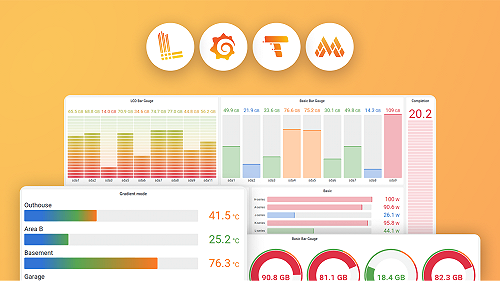MongoDB query editor
Grafana provides a query editor for MongoDB that supports the same syntax as the MongoDB Shell (mongosh), but with the following limitations:
- You can only run one command or query per query.
- Only
findandaggregateread commands are supported. ISODateis the only supported object constructor.
For an introduction to writing scripts for the MongoDB shell refer to Write scripts in MongoDB documentation. You create a query in Grafana’s query editor in the same way you would in the MongoDB shell.
Example:
sample_mflix.movies.aggregate([
{"$match": { "year": {"$gt" : 2000} }},
{"$group": { "_id": "$year", "count": { "$sum": 1 }}},
{"$project": { "_id": 0, "count": 1, "time": { "$dateFromParts": {"year": "$_id", "month": 2}}}}
]
).sort({"time": 1})Additional syntax
The editor extends the MongoDB Shell syntax by means of database selection, where you can use a database name instead of db. For example, sample_mflix.movies.find(). You can still use db to refer to the default database in your connection string.
It also extends it by means of aggregate sorting. Sorting typically happens within the aggregate pipeline. The extended syntax is allowed on aggregate similarly to find. For example, sample_mflix.movies.aggregate({}).sort({"time": 1}).
Note
MongoDB does not perform the sort with this syntax. Sorting occurs after retrieving the results from the collection.
Collections with a dot
To query collections that contain a dot (.) in their name, use the following syntax:
my_db.getCollection("my.collection").find({})Keyboard shortcuts
Press Ctrl+Space to show code completion, which is displayed after entering a . after a database, collection, query method, or aggregation method name. Pressing Cmd + S runs the query.
Query as time series
Create a time series query by aliasing the date field as time.
Note
You can convert non-date fields into date fields and alias them as
timeto create a time series query.
The following query converts the int field year to a date that is projected as time using the MongoDB $dateFromParts pipeline operator:
sample_mflix.movies.aggregate([
{"$match": { "year": {"$gt" : 2000} }},
{"$group": { "_id": "$year", "count": { "$sum": 1 }}},
{"$project": { "_id": 0, "count": 1, "time": { "$dateFromParts": {"year": "$_id", "month": 2}}}}
]
).sort({"time": 1})If you want to group your time series by Metric, project a field called __metric.
The following query displays the count of movies over time by movie rating using __metric:
sample_mflix.movies.aggregate([
{"$match": { "year": {"$gt" : 2000}}},
{"$group": { "_id": {"year":"$year", "rated":"$rated"}, "count": { "$sum": 1 } }},
{"$project": { "_id": 0, "time": { "$dateFromParts": {"year": "$_id.year", "month": 2}}, "__metric": "$_id.rated", "count": 1}}
]
).sort({"time": 1})Diagnostics
MongoDB provides diagnostic commands to help monitor and troubleshoot database performance, health, and operations. For information about diagnostics commands, refer to Diagnostic Commands in MongoDB documentation.
The plugin supports the following MongoDB diagnostic commands:
buildInfoconnPoolStatsconnectionStatusdbStatsgetLoghostInfolockInforeplSetGetStatusserverStatusstats
Macros
To simplify syntax and to allow for dynamic times, you can write queries that contain macros. The MongoDB plugin supports the following macros:
Dynamic dates in queries
Starting with version 1.14.2, the Grafana MongoDB plugin no longer supports performing arithmetic on dates directly within the query editor. In earlier versions of MongoDB (prior to version 5), date arithmetic was commonly used to filter documents.
Example:
sample_mflix.movies.find({ $gte: new Date(new Date().setMonth(new Date().getMonth() - 3)) })With MongoDB version 5.0 and later, new operators such as $dateSubtract and $dateAdd were introduced. These operators provide more robust and flexible date manipulation, especially within aggregation queries.
The following example uses $dateSubtract to filter documents on the “mflix” sample dataset:
sample_mflix.movies.aggregate([
{
$match: {
$expr: {
$gt: [
"$released",
{
$dateSubtract: {
startDate: "$$NOW",
unit: "year",
amount: 9
}
}
]
}
}
}
])The query filters for movies released in the last 9 years using MongoDB native date manipulation features.



